
 Share
Share

 Print
Print
The AMM describes the procedures on how A/C maintenance shall be carried out. The manufacturers for this manual are Boeing-Airbus, Embraer, and Bombardier-Fokker.
The system allows the user to load and import AMMs into a database via TraxDoc.
The following topic will detail the following:
- How to create a TraxDoc for the AMM doctype
- How to Load an AMM into TraxDoc (including images)
- How to Load a Stylesheet
- How to Import the AMM into the system
TraxDoc Setup (AMM):

Create a TraxDoc by selecting the New Detail ![]() button in the TraxDoc Master window.
button in the TraxDoc Master window.
The TraxDoc Document Detail window will open. Enter all required information in each of the TraxDoc Document Detail window's tabs.
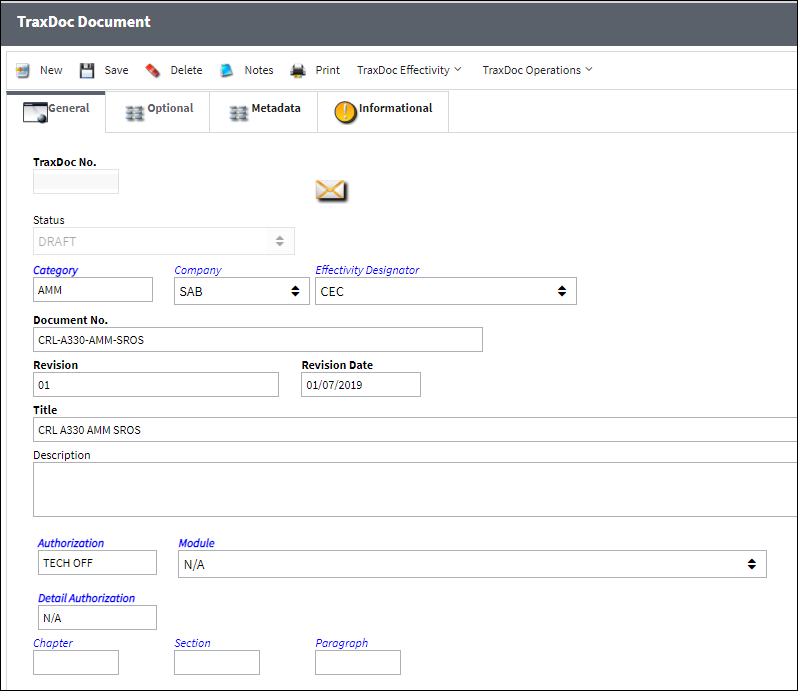
Ensure that "Aircraft Maintenance Manual (AMM)" is specified as the SGML/XML Doctype in the TraxDoc Document Detail, Optional tab.
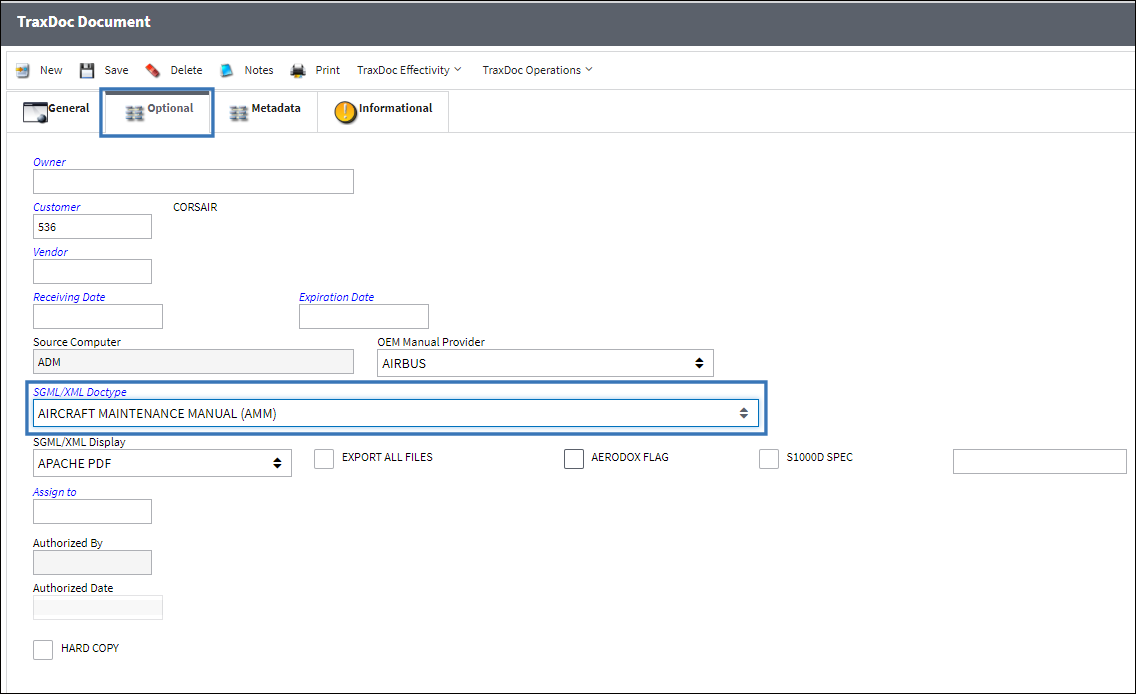
Then, select the Save ![]() button to finalize the creation of the TraxDoc.
button to finalize the creation of the TraxDoc.
Users should also ensure that the TraxDoc is given the correct effectivity settings. Effectivity is set up by selecting the Effectivity ![]() button from the TraxDoc Effectivity dropdown menu on the toolbar.
button from the TraxDoc Effectivity dropdown menu on the toolbar.
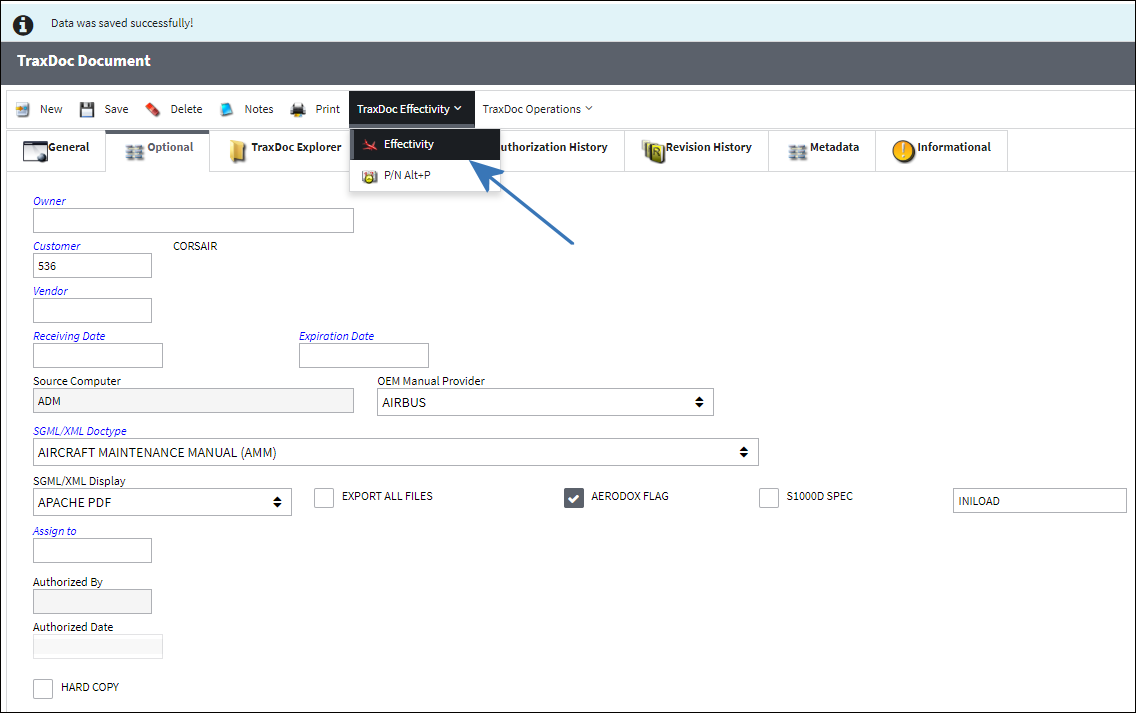
Loading an XML into TraxDoc:
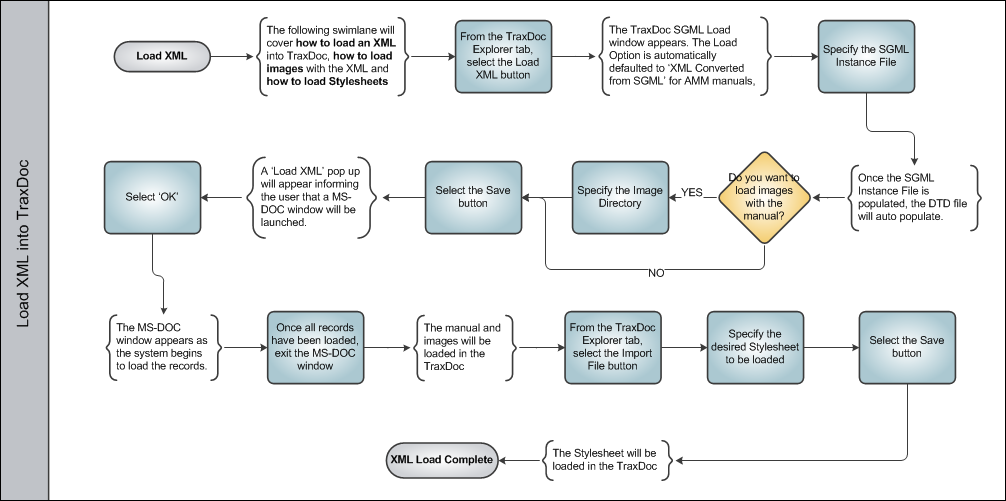
From inside the TraxDoc Document Detail window, navigate to the TraxDoc Explorer tab and select the Load OEM Files ![]() button.
button.
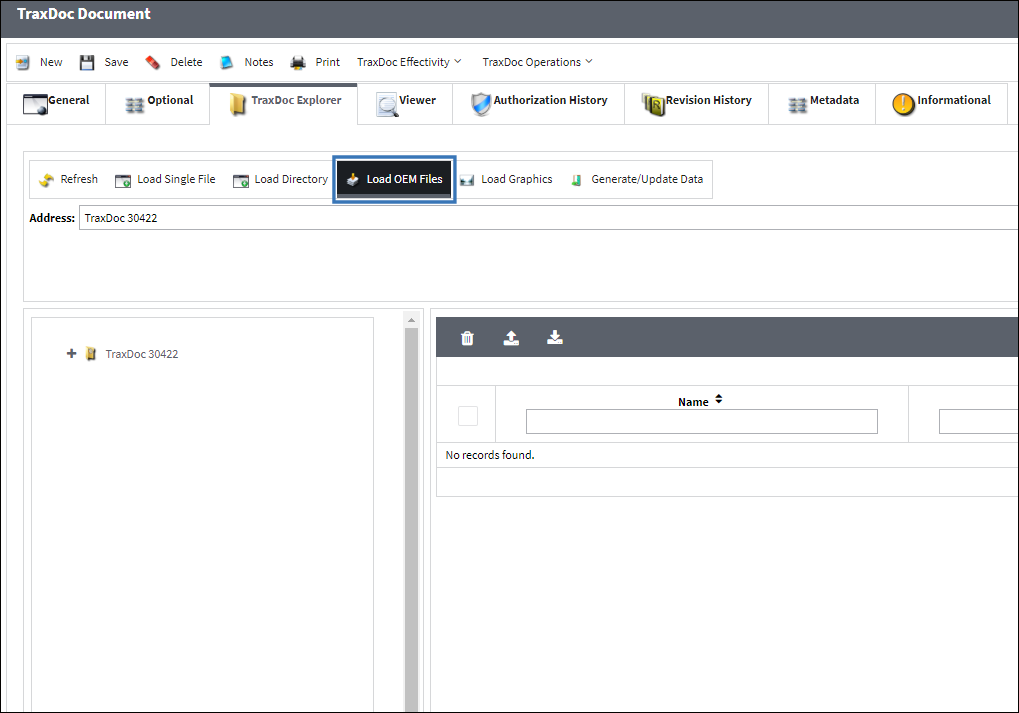
This will open the TraxDoc SGML Load window.
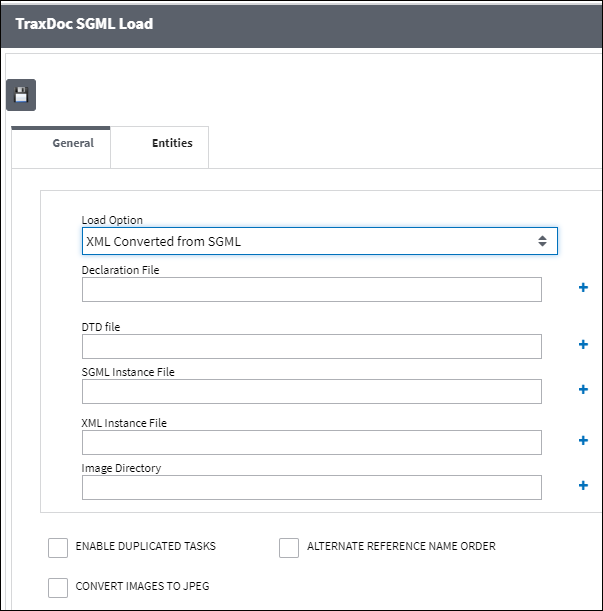
The following information/options are available in this window:
_____________________________________________________________________________________
Load Option
Select from one of the following Load Options:
- XML Converted from SGML
- Graphics
- XML
Note: The Load Option field in this window should already be set to the "XML Converted from SGML" option. The system will always default to the recommended Load Option based on the selected TraxDoc's SGML/XML Doctype.
Declaration File
Select the manual’s declaration file, if any. This file is located in the SGML folder and will end should end in .sdl.
DTD File
Select the manual’s DTD (Document Type Definition) file. This file is located in the SGML folder and should end in .dtd.
SGML Instance File
Select the specified SGML file.
XML Instance File
Select the specified XML file. This does not pertain to the AMM load.
Image Directory
Browse the directory (on the portable media) where images are stored and and select media to be imported.
Load Zip Folder
Select this option to load a zipped folder.
Enable Duplicate Tasks checkbox
Select this checkbox to load duplicate tasks from duplicate chapters. The TraxDoc XML Load program will add the last four digits of the XML file name to each task, regardless if the task is repeated or not.
Convert Images to JPEG checkbox
Select this checkbox to convert images (i,e .PNG, .CGM, etc.) to .JPEG. This checkbox is important for those customers who use a third party DLL who does not support certain image types, therefore they must be converted to .JPEG.
Alternate Reference Name Order checkbox
When this checkbox is selected, elements with ATA information such as Task/Subtask will be in the form (CHAPNBR-SECNBR-SUBJNBR-FUNC-SEQ-VARNBR-CONFLTR). When this checkbox is de-selected, these items will be in the form (CHAPNBR-SECNBR-SUBJNBR-FUNC-SEQ-CONFLTR-VARNBR).
_____________________________________________________________________________________
Select the Add SGML Instance File![]() button.
button.
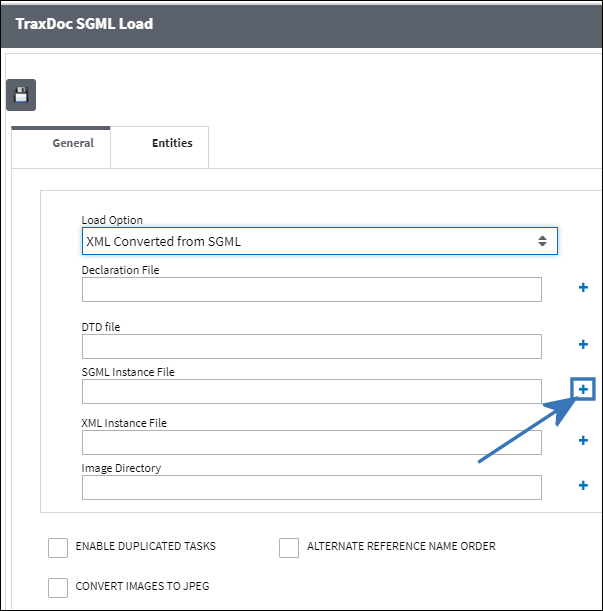
This should reveal the Trax File Explorer panel, which lets users search through directories and files that have been uploaded into TraxDoc.
When uploading a document into TraxDoc, the file that is being uploaded must be in a location where the eMRO server will recognize it. See below instructions:
- The IT department on the user side must select a directory to work as a repository for all the OEM manuals that would be uploaded to eMRO via the TraxDoc module.
- This directory must be accessible from the application server (Wildfly).
- Create a way for users to provide the OEM manual revisions to be placed in the repository.
- The path for the repository directory will be defined by the traxdoc_manual variable on the data.source.properties file. This can be found under the application server (/%WILDFLYHOME%/deployments/emro.war/WEB-INF/classes/resources/).
SaaS customers should refer to the instructions outlined in this document in iCentral: SaaS - How to Upload TraxDoc Manuals.
Use the Trax File Explorer to find the relevant SGML Instance file.
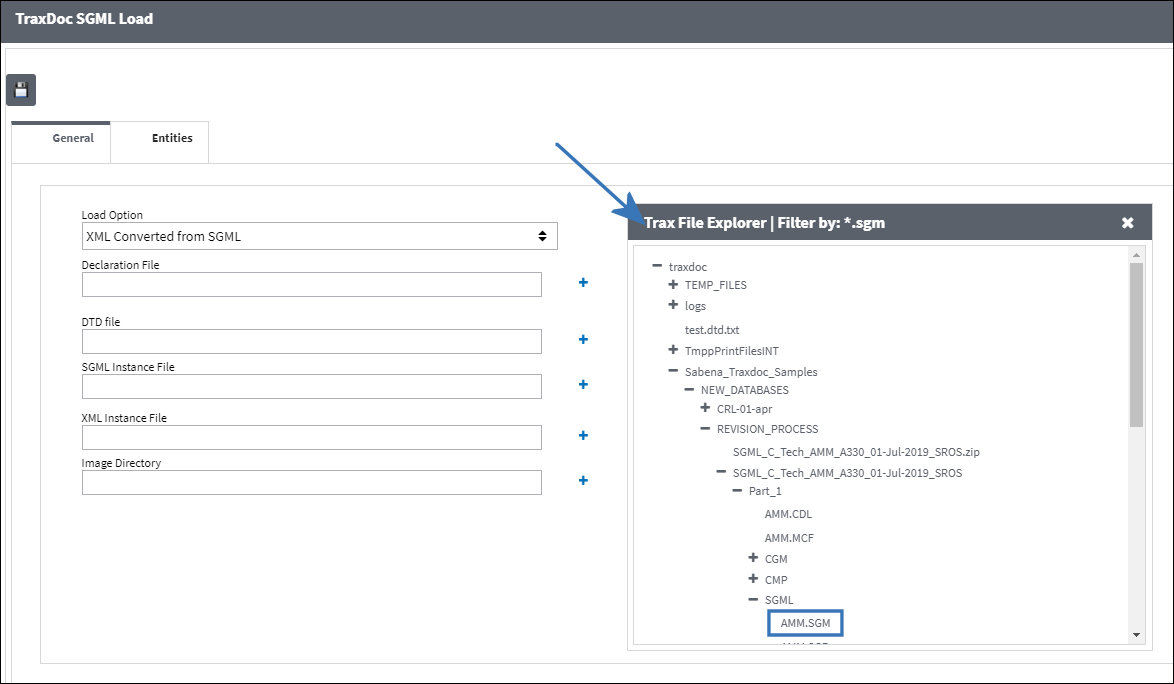
![]() Note: The TraxDoc files displayed in the SGML Load window are sorted alphabetically.
Note: The TraxDoc files displayed in the SGML Load window are sorted alphabetically.
Once selected, the SGML Instance File as well as the DTD File field are automatically populated.
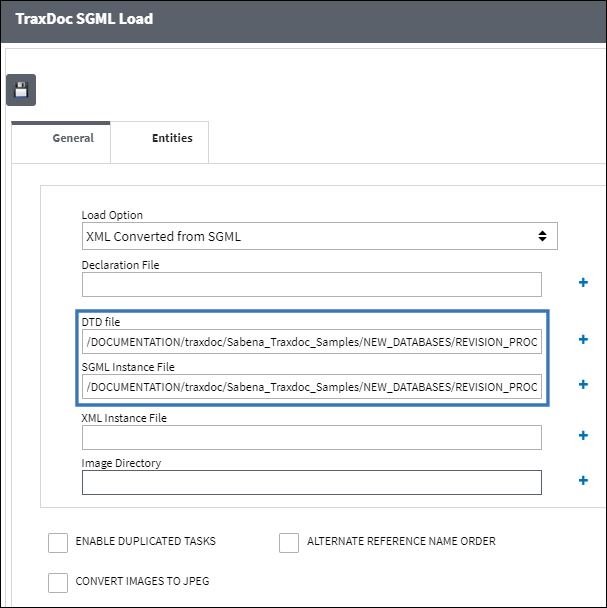
Once the Save ![]() button is selected, the system will automatically convert the SGML file to XML (as a result of the selected Load Option).
button is selected, the system will automatically convert the SGML file to XML (as a result of the selected Load Option).
To verify whether the system has recognized all required files, navigate to the Entities tab.
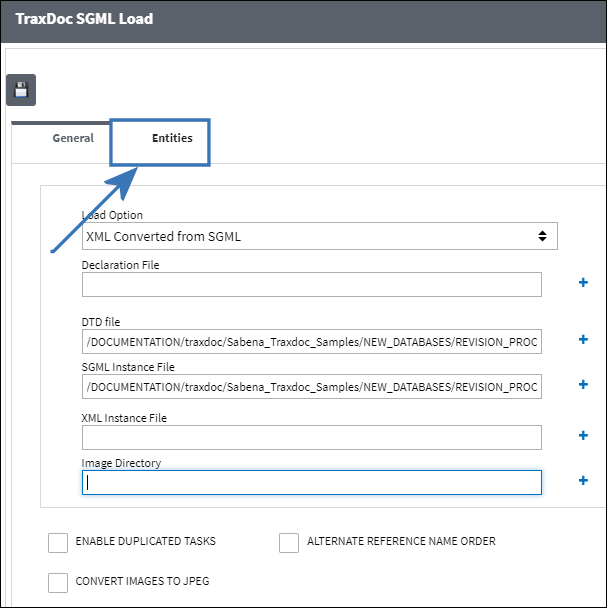
The Entities tab lists all the required files that the system has recognized. If files are missing from this list or have been added by mistake, they can be added or removed manually using the New and Remove buttons.
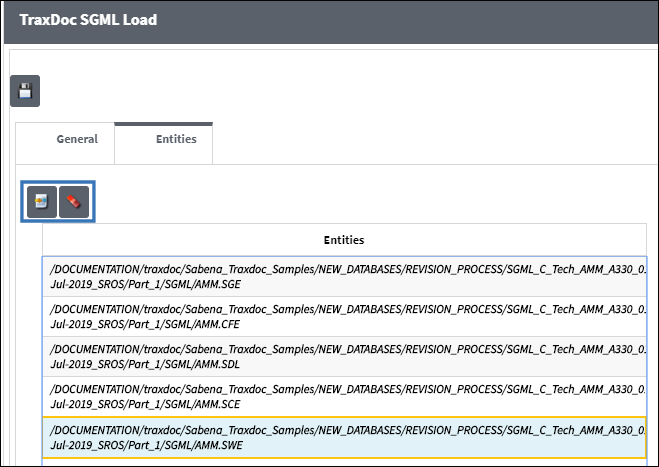
Load Images into TraxDoc:
From inside the TraxDoc SGML Load window, select the Add Image Directory ![]() button.
button.
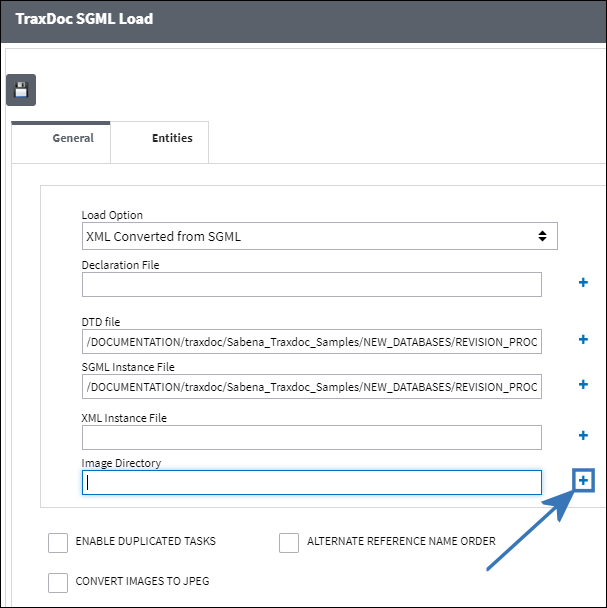
The Trax File Explorer panel will be displayed. Use it to find and select the directory that contains the desired images.
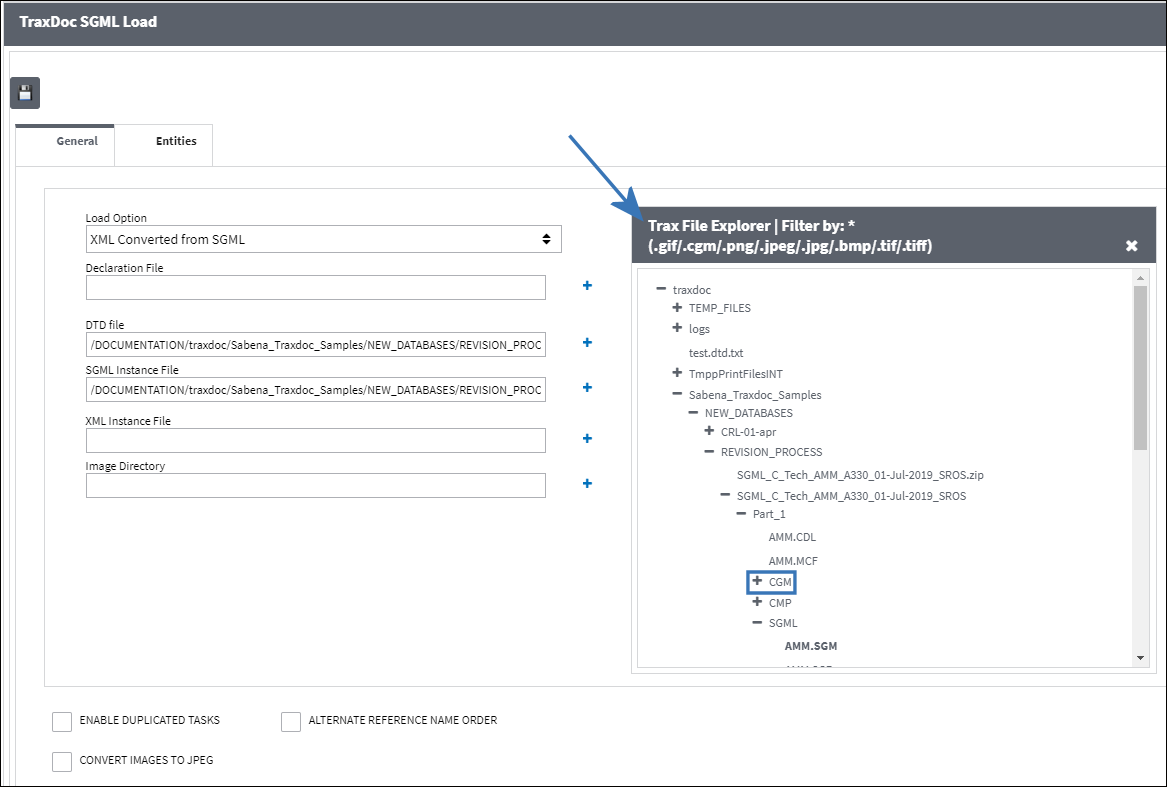
Once the Image Directory is specified, select the Save ![]() button.
button.
Importing AMM into the system:

Once the SGML has been loaded successfully into the selected TraxDoc, the user must import the manual into the system.
From the TraxDoc Document Detail, TraxDoc Explorer tab, select the Generate/Update Data ![]() button.
button.

The Task Card Create from AMM window appears. Populate all mandatory and desired information and run the import the same as any other.
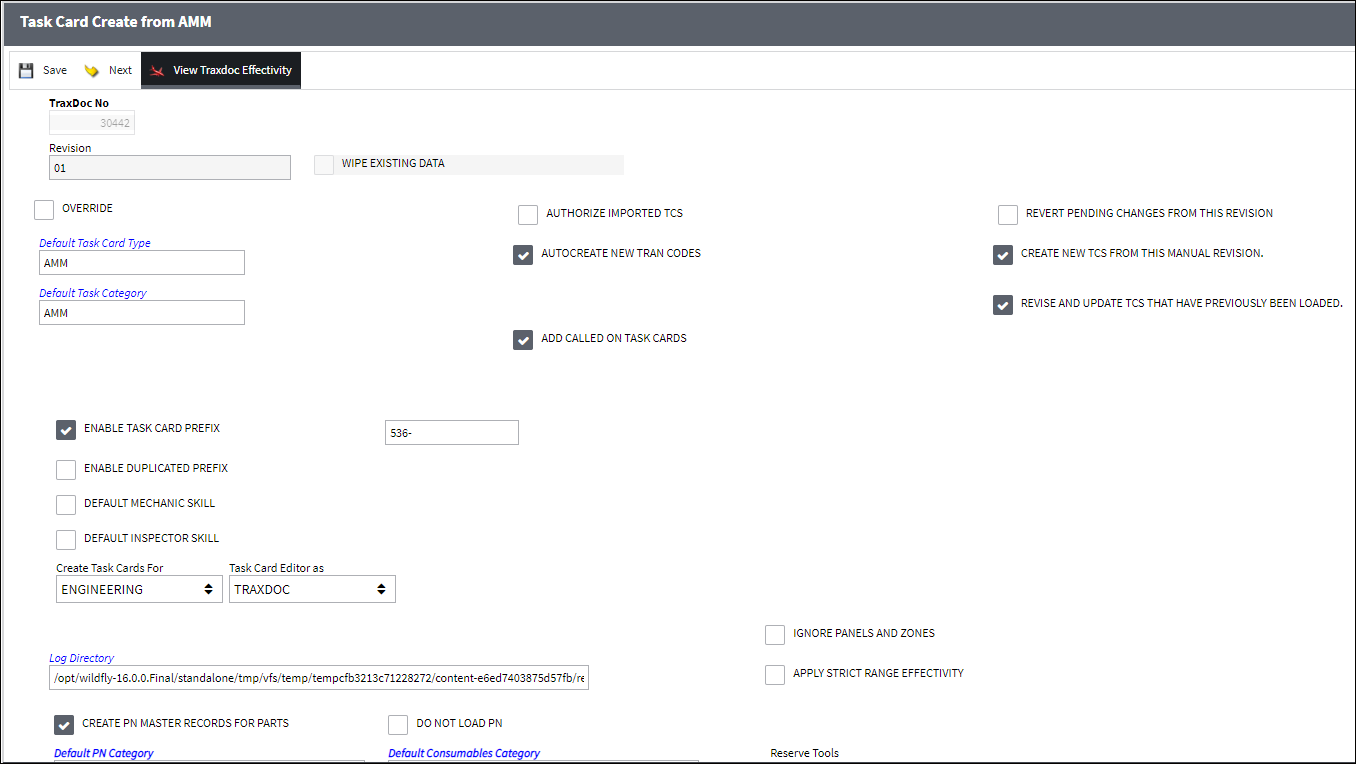
Note: Effectivity can also be reviewed through the View AMM Effectivity ![]() button.
button.
The following information/options are available in this window:
_____________________________________________________________________________________
TraxDoc No.
The TraxDoc Document ID number, which is automatically generated by the system.
Revision
The document’s current revision number. Each TraxDoc can have multiple revisions as the data/records created through the TraxDoc will need to be updated (revised) regularly depending on the requirements of the aircraft manufacturer, regulatory agency, airline, etc.
Override checkbox
Select this checkbox to override the Revision for Task Cards that are being imported.
Default Task Card Type
The Task Card Type. This is useful in the sort and locating of the Task Card.
Default Task Category
Select the Task Card Category to be assigned to all Task Cards being created/revised from this import. Task Card Category will delegate the authorization process and send notifications as defined in the System Transaction Codes.
Company
The imported T/C will be created for the selected company.
Note: When importing new revisions of existing T/Cs, only the selected company's records will be updated to the new revision.
Note: When the 'ALL' option is selected from the Company drop down field, the imported T/Cs will be created/revised for each company in the system. The records will not be company-specific.
Note: For more information, refer to the Multi Company Functionality.
Wipe Existing Data checkbox
Select this checkbox to replace the existing data with the data from the new revision.
![]() This checkbox is security controlled via TraxDoc/ Update/ TraxDoc Master/ Import From OEM Manual Button.
This checkbox is security controlled via TraxDoc/ Update/ TraxDoc Master/ Import From OEM Manual Button.
Authorize Imported TCs
Select this checkbox to automatically authorize all Task Cards created.
Autocreate New Tran Codes checkbox
Some of the Task Card information provided in OEM manuals is controlled by Tran codes (i.e. Task Card types, areas, and skills). Selecting this checkbox will automatically create a Tran code record for any values found in the manual. If this box is not checked, the fields will still be set in the Task Card, but will have to be changed manually when working with the task card. This option is unchecked by default.
Add Called On Task Cards checkbox
Select this checkbox to automatically import Task Cards linked together with the Calling Task Card functionality.
For more information, refer to the Calling Task Card Button, via the Task Card section of the eMRO Engineering Module - T/C manual.
Revert Pending Changes from this Revision
Select this checkbox to revert pending changes to the revision. Any new Task Cards created for this revision will also be deleted.
Create New TCs from this Manual Revision checkbox
Select this checkbox to create new Task Cards from the current manual revision.
Revise and Update TCs that have Previously been Loaded checkbox
Select this checkbox to revise and update Task Cards that have previously been loaded.
Control
Users can choose between the two Control types: A/C or P/N. When A/C is chosen, users can specify the Aircraft by selecting into the field.
Enable Task Card Prefix checkbox
Select this checkbox to allow a prefix to be assigned to Task Cards being imported.
Task Card Prefix - The prefix to be assigned to the T/C being imported.
Enable Duplicated Prefix checkbox
Select this checkbox to allow a duplicate prefix to be assigned to Task Cards being imported.
Duplicated Prefix - A duplicate of the prefix to be assigned to the T/C being imported.
Default Mechanic Skill checkbox
Select this checkbox if the mechanic skill is mandatory. The Default mechanic skill field will become mandatory once this checkbox is selected.
Default Mechanic Skill - The default mechanic skill for the Task Card items created if this is not supplied by the OEM manual. The skill will default to the mechanic skill specified in the ATA Chapter/Section. If there is no skill defined in the ATA Chapter/Section, the skill will then default to the mechanic skill specified in the Task Card Create from AMM import window.
Default Inspector Skill checkbox
Select this checkbox if the inspector skill is mandatory. The Default inspector skill field will become mandatory once this checkbox is selected.
Default Inspector Skill - The default inspector skill for the Task Card items created if this is not supplied by the OEM manual. The skill will default to the mechanic skill specified in the ATA Chapter/Section. If there is no skill defined in the ATA Chapter/Section, the skill will then default to the inspector skill specified in the Task Card Create from AMM import window.
Create Task Cards For drop down
Select the module required to load the SGML Task Card to: Engineering, Shop, GSE.
Ignore Panels and Zones checkbox
When selected, the system when creating or revising Task Cards will not include the Panels and Zones indicated in the AMM; the Panels/Zones for imported or revised T/Cs will be set to 'null'. When deselected, the Panel and Zone data for the T/Cs in the manual will be included in the T/Cs that were imported into the Engineering module. Regardless of the checkbox setting, when a revision is imported, any edits to the Panels/Zones done in the Engineering module between AMM revisions will be overridden to either 'null' (if the checkbox is selected) or to the data from the TraxDoc revision (if deselected).
![]() Note: When importing a Revision of the manual and the 'Ignore Panels and Zones' checkbox is selected, the existing T/Cs will have their Panels and Zones unaffected by the Panel/Zone data from the revision being imported. This ensures that if the Panel and Zone data was manually updated in the Engineering module for those Task Cards, those edits will be retained after the TraxDoc revision is imported. In previous versions of TRAX, the 'ignore' function would have set the Panel/Zone data to 'null'.
Note: When importing a Revision of the manual and the 'Ignore Panels and Zones' checkbox is selected, the existing T/Cs will have their Panels and Zones unaffected by the Panel/Zone data from the revision being imported. This ensures that if the Panel and Zone data was manually updated in the Engineering module for those Task Cards, those edits will be retained after the TraxDoc revision is imported. In previous versions of TRAX, the 'ignore' function would have set the Panel/Zone data to 'null'.
This checkbox also works in conjunction with TraxDoc Switch ![]() TRXDCRUNPKG. For more information refer to the TraxDoc Switches Manual.
TRXDCRUNPKG. For more information refer to the TraxDoc Switches Manual.
Log Directory
This option allows the user to specify the directory to which log files and error reports will be saved. The initial value is a sub-folder inside the default temporary directory.
Apply Strict Range Effectivity checkbox
When checked, imported Task Cards/Engineering Controls will be made effective to all Aircraft Type/Series, regardless of whether or not tail-level effectivity is specified in the manual. Positions, Zones, Panels, References, etc. will also be created for all type/series. If unchecked, effectivity will only be created for those type/series that have a least one effective Aircraft specified in the manual.
Update TC Title checkbox ![]()
Select this checkbox to update the Description of the Task Cards being revised. When not selected, when a revision to a Task Card is imported, the T/C's Description in the Engineering module will remain the same and not be updated by the revision.
Task Card Editor As drop down
Select the editor type to create the format of the Task Card. The user may select from the following options:
- TRAXDOC
- TASKCARD
Note: When the TASKCARD Editor is selected, the items of the Task Card will be generated in RTF.
Create P/N Master Records for Parts checkbox
Select this checkbox to auto create records in the P/N Master for any parts found in the manual. When this checkbox is selected, the following fields appear:
Default PN Category - This P/N Category field in this window is referring to only Expendable and Consumable part numbers. This determines how the system will handle this part. If the Category entered is Expendable or Consumable, the system will be expecting either an Expendable or Consumable number for every item in the system for this part number.
Default Consumables Category - This P/N Category field in this window is referring to only Expendable and Consumable part numbers. This determines how the system will handle this part. If the Category is a 'non-serialized' or a 'kit' type then the system will not be expecting serial numbers for every item.
Note: The user must enter default values to place in these fields in case the AMM does not contain data for them. Parts for this category are identified by the CONNBR tag.
Default Tools Category - This P/N Category field in this window is referring to Tool part numbers. This determines how the system will handle this part. A Tool P/N Category can be defined as serialized or non-serialized. If serialized, the system will be expecting serial numbers for every item in the system for this part number. The user must enter default values to place in these fields in case the AMM does not contain data for them. Parts for this category are identified by the TOOLNBR tag.
Default PN Stock UOM - The ATA code for Unit Of Measurement (or internal code if preferred). The Order UOM differentiates by Stock UOM a unit of conversion may be defined in the UOM code which will automatically convert the Order UOM to the Stock UOM at receiving.
Note: The user must enter default values to place in these fields in case the AMM does not contain data for them.
Default PN Vendor - The Manufacturer or main Vendor for this part. The Vendor must be flagged in the Vendor Master as a Manufacturer to populate this field.
Note: The user must enter default values to place in these fields in case the AMM does not contain data for them.
Default PN Description - The description of the part number.
Note: The user must enter default values to place in these fields in case the AMM does not contain data for them.
Do Not Load PN checkbox
When this checkbox is selected, the system will not load the P/Ns against the Task Card(s) created with the import.
Reserve Tools - Select from one of the following radio buttons:
Reserve radio button - Select this button to reserve the spare or tool when W/O P/N reservation is applied.
Repair Return radio button - Select this button to repair/return the spare when W/O P/N reservation is applied.
None radio button - Select this button if no spare or tool has been reserved or repaired.
_____________________________________________________________________________________
Select the Next![]() button. The following window will be displayed:
button. The following window will be displayed:
![]() Note: The Search Bar allows users to find/filter Available Tasks by entering the relevant name.
Note: The Search Bar allows users to find/filter Available Tasks by entering the relevant name.

Select the Task Cards to be imported. Use the buttons in the middle of the window to move the Task Cards from the Task(s) / Requirement(s) panel to the Task(s) Requirement(s) to Import panel.
Once all desired Task Cards have been moved to the right panel, select the Run ![]() button.
button.

The Task Card Import will then start and run in the background. Users can review the current status of the import in the TraxDoc Progress window.
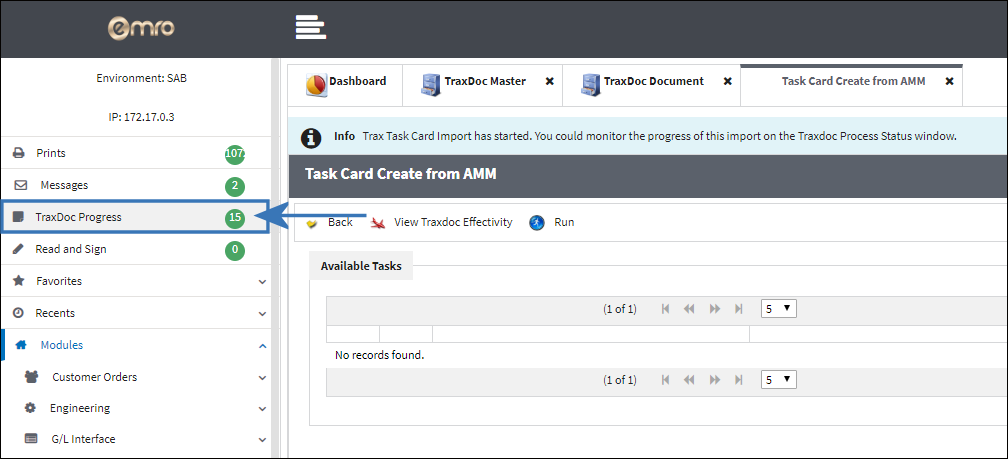
In this case, the Task Card import process is listed in the Generate/Update Data Processes section. Once it finishes, the Status field will change to COMPLETED.


 Share
Share

 Print
Print